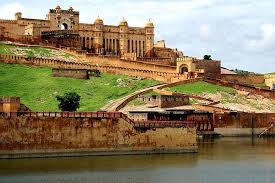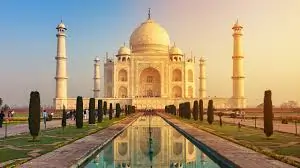The Varanasi Ghats, Known for the mesmerizing evening Ganga Aarti at Dashashwamedh Ghat, these ghats embody the vibrant spiritual essence of one of India’s holiest cities.
ADVERTIDEMENT

Table of Contents

Varanasi Ghats (Uttar Pradesh)
The Varanasi Ghats are a series of steps along the banks of the Ganges River in the ancient city of Varanasi, Uttar Pradesh, India. These ghats, numbering over 80, are significant both spiritually and culturally, as they provide places for religious rituals, daily life activities, and gatherings. Each ghat has its own distinct purpose and significance, ranging from bathing and worship to cremation and meditation.
In Hinduism, Varanasi Ghats is considered one of the holiest cities, and the Ganges River is seen as a purifier of sins. For centuries, people have visited the ghats to perform sacred baths, conduct rituals, offer prayers, and, in some cases, perform last rites for loved ones. The ghats are also known for the evening Ganga Aarti ceremony, especially at Dashashwamedh Ghat, where priests conduct an elaborate fire ritual as a tribute to the river. The ghats are not only places of worship but also vibrant public spaces, filled with the sights and sounds of Varanasi’s spiritual life, making them an essential part of the city’s cultural and religious identity
I. Introduction
Overview of Varanasi and the Ghats’ Importance
Introduction to Varanasi as a sacred and ancient city located on the banks of the Ganges River in Uttar Pradesh, India. Brief discussion of Varanasi’s spiritual prominence, as it is believed to be the earthly home of Lord Shiva and an eternal city where people seek liberation.
Role of the Ghats in Varanasi’s Identity
Explanation of the ghats as a defining feature of Varanasi, with over 80 ghats spanning several kilometers along the river. Mention that the ghats serve as a microcosm of Varanasi, where life, spirituality, and death intersect in the daily lives of locals, pilgrims, and tourists. Introduction to the various uses of the ghats, from sacred rituals and meditation to bathing, cremation, and gathering for cultural events.
II. Historical and Religious Significance
Origins of Varanasi and Its Connection to Hinduism
Discussion of Varanasi as one of the oldest continuously inhabited cities in the world, with references to the city dating back over 3,000 years in Hindu scriptures.Mythological connection to Lord Shiva, who is believed to have established Varanasi as a place of divine energy and spiritual importance.
Development and Patronage of the Ghats
Overview of the historical construction and renovation of the ghats, with major contributions from Maratha rulers and other regional kings during the 18th century.
Explanation of how rulers from across India, particularly the Marathas, contributed to the development and upkeep of the ghats, adding to their religious importance and architectural beauty.
Religious Importance of the Ganges River
Insight into the belief that the Ganges River is the holiest river in Hinduism, viewed as a goddess (Ganga) who purifies sins and blesses those who come in contact with her waters.
Explanation of how bathing in the Ganges at the Varanasi Ghats is thought to cleanse one’s sins and purify the soul, making it a key pilgrimage destination for millions of Hindus.
Discussion of Varanasi’s significance as a place for performing last rites and funeral rituals, with the belief that dying in Varanasi Ghats or having funeral rites performed here grants liberation (moksha) from the cycle of rebirth.
III. Key Ghats and Their Unique Roles
Dashashwamedh Ghat
Introduction as the most famous and frequently visited ghat, known for its vibrant, bustling atmosphere. Legend that Lord Brahma created this ghat to welcome Lord Shiva to Earth, making it one of the most spiritually important locations. Details of the evening Ganga Aarti ceremony held daily at Dashashwamedh Ghat, which draws large crowds for its visually captivating ritual with fire, chants, and lamps.
Manikarnika Ghat
Known as the oldest and holiest cremation ghat in Varanasi Ghats, where funeral pyres burn continuously. Description of the ghat’s role in Hindu beliefs surrounding death and liberation, as cremation here is said to release souls from the cycle of reincarnation. Mythological significance, with stories linking Manikarnika Ghat to both Vishnu and Shiva, enhancing its spiritual importance.
Assi Ghat
Description of Assi Ghat as a quieter ghat popular for sunrise prayers, yoga, meditation, and peaceful reflection. Explanation of its significance to pilgrims seeking a more tranquil setting to connect with the river and participate in morning rituals.
Harishchandra Ghat
Overview of Harishchandra Ghat as another cremation site with its own religious significance and connections to Hindu mythology, specifically the story of King Harishchandra’s dedication to truth. Importance of this ghat as a secondary cremation site for Hindus who wish to perform funeral rites outside the main Manikarnika Ghat.
Tulsi Ghat
Historical and literary significance of Tulsi Ghat, named after the poet-saint Tulsidas, who composed parts of the Ramcharitmanas (a retelling of the Ramayana) here. Description of Tulsi Ghat as a place of literary heritage, attracting devotees of Tulsidas and visitors interested in the intersection of literature and spirituality.
IV. Daily Life and Rituals at the Ghats
Morning Rituals and the Symbolism of Sunrise
Insight into the significance of morning activities, such as taking ritual baths, performing yoga, reciting prayers, and chanting, which contribute to the spiritually charged atmosphere. Explanation of why sunrise is considered a sacred time, with devotees and tourists gathering along the ghats to witness the city’s ritualistic start to the day.
Evening Ganga Aarti Ceremony at Dashashwamedh Ghat
Detailed look at the Ganga Aarti ceremony, where priests use fire lamps, incense, conch shells, and chanting to perform offerings to the Ganges. Visual appeal of the ceremony, attracting both locals and tourists who gather to experience the spiritual energy and devotion expressed through the ritual. Explanation of the significance of the Ganga Aarti as a tribute to the river and its role as a sustainer of life.
Cremation and Last Rites at Manikarnika and Harishchandra Ghats
Description of the cremation process and customs, including the rituals performed by families as they bid farewell to their loved ones. Importance of Manikarnika and Harishchandra Ghats as places where death and spirituality meet, with a focus on Hindu beliefs about death, rebirth, and liberation.
Daily Life and Community Interaction on the Ghats
Glimpses of the bustling activity along the ghats, where flower vendors, local priests, pilgrims, and tourists come together. Examples of everyday life, including rituals, commerce, art, and interaction between locals and visitors that reflect Varanasi’s unique way of life.
V. Cultural and Tourist Experience
Immersive Activities for Visitors
Overview of popular activities for tourists, including boat rides at sunrise and sunset, walking tours in Varanasi Ghats, and opportunities to participate in or observe rituals.Description of the boat rides along the river, offering visitors a panoramic view of the ghats and a chance to witness morning or evening rituals from a different perspective.
Photography and Artistic Inspiration
Explanation of why the ghats are popular among photographers, artists, and filmmakers who seek to capture the vivid colors, spiritual expressions, and ancient atmosphere of Varanasi Ghats. Mention of the Varanasi Ghats as an inspiration for art that depicts the spirituality, beauty, and depth of India’s cultural heritage.
Ethical Guidelines and Respect for Local Customs
Importance of cultural sensitivity, especially regarding photography and respectful behavior during ceremonies and cremation rituals.Encouragement for visitors to observe quietly, respect the sanctity of religious practices, and follow local guidelines when engaging with spiritual or cultural events.
VI. Conservation and Challenges
Efforts to Preserve the Ghats and the Ganges River
Description of ongoing initiatives by the government and NGOs to clean and maintain the Varanasi Ghats and improve the water quality of the Ganges. Mention of specific programs like the Namami Gange Project, which aims to address pollution, restore the river’s ecosystem, and promote sustainable practices along the Varanasi Ghats.
Environmental and Cultural Challenges
Discussion of environmental issues, such as pollution from waste, sewage, and industrial runoff that threaten the health of the Ganges. Challenges in balancing the preservation of traditional practices with the modern needs of urban development and tourism, which increase stress on the river and the Varanasi Ghats.
VII. Conclusion
In conclusion, the Varanasi Ghats are much more than a series of riverfront steps; they are a profound embodiment of India’s spiritual and cultural heritage. These ghats capture the essence of Varanasi, where the sacred and the everyday coexist, and where rituals of life and death unfold with deep reverence. From the morning prayers and ritual baths to the evening Ganga Aarti and continuous cremation rites, the ghats are an enduring symbol of devotion, spirituality, and the belief in liberation in Varanasi Ghats.
As places of immense historical, religious, and cultural significance, the Varanasi Ghats provide a unique, immersive experience that connects people to the heart of Hindu tradition and the city’s ancient heritage. Their preservation is vital, not only for the millions of pilgrims who find solace and purpose along the Ganges but also for future generations who will continue to find inspiration in their beauty and sanctity. Varanasi’s ghats remind us of the timeless relationship between humanity and the divine, offering a window into the enduring spirit of one of the world’s oldest cities.

